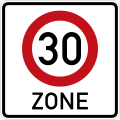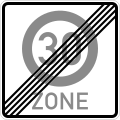Tempo 30 zone
A Tempo 30 zone is an area of public road traffic within which all vehicles are allowed to move at a maximum speed of 30 km / h. Zones of this type serve to calm traffic . They are particularly common in residential areas .
history
Germany
The inner city of Buxtehude was declared the first Tempo 30 zone in Germany on November 14, 1983 as part of a model test. In the 1980s, numerous German cities introduced Tempo 30 zones in their residential areas. For example, the city of Munich set up its first 30 km / h zone ( settlement on Lerchenauer See ) on January 19, 1988.
Austria
On September 1, 1992, the city of Graz set the maximum speed on all roads with the exception of the main roads to a maximum of 30 km / h. The 7th Viennese district of Neubau is the first Viennese district to use Tempo 30 across the board. In the 6th district of Mariahilf there is only Tempo 50 in Linke Wienzeile . In Vienna, the construction of Tempo 30 began in the late 1980s. Zones.
Switzerland
In Switzerland, Tempo 30 zones were legally regulated in 1989 and then set up for the first time in Winterthur in 1990 . In 1994, the first Tempo 30 zone was introduced in St. Gallen . From 2005 , a 30 km / h speed regime was tested in Köniz as part of a pilot project on Schwarzenburgstrasse, a busy main road with an average daily traffic volume of 17,000 vehicles. After the successful pilot project, the regime was finally introduced in the same year. The adjustments were made as part of a major renovation based on the Bern model . In 2013, Tempo 30 was introduced across the board on all neighborhood streets in Bassersdorf . Towards the end of the 2010s, the increased introduction of Tempo 30 on main roads led to resistance. For example, National Councilor Gregor Rutz ( SVP ) tried to change the Road Traffic Act with a parliamentary initiative . His proposal was accepted by the National Council. However, the Transport Commission of the Council of States rejected Rutz's proposal with 9 to 2 votes with 2 abstentions. Against the initiative z. B. the Swiss Association of Cities lobbied. Finally, in mid-June 2019, the Council of States rejected the initiative by 20 to 16 votes with one abstention. Thus the Rutz initiative failed. As of March 2018, Basel had already converted 56 percent of the inner-city road network to Tempo 30 zones. Tempo 40 zones were previously known in Switzerland.
France
On July 8, 2019, a nationwide 30 km / h zone was set up in Bègles .
purpose
A Tempo 30 zone can be set up for the following reasons:
- Increase in traffic safety (especially safety on the way to school)
- Improvement of the quality of living and amenity (e.g. through less road traffic noise and air pollution )
Signage
The traffic rules for Tempo 30 zones and their signage are regulated in the road traffic laws of the respective countries and are largely similar.
In Germany, Austria, Switzerland and numerous other countries, a corresponding sign is put up at the beginning and at the end of a Tempo 30 zone.
The announcement of a 30 km / h zone can be done in addition to the signage by means of area marking applied to the roadway. This is red with a white frame and a white framed 30 in the middle, but sometimes only the number 30 in white, but the lane marking alone has no meaning without the corresponding sign.
Legal situation in Germany
In Germany, Tempo 30 zones are set up on the basis of Section 45 Paragraph 1c of the StVO . The beginning of the Tempo 30 zone is marked with symbol 274.1, the end with symbol 274.2. The right of way within a Tempo 30 zone is basically determined by the rule “right before left” ( § 8 StVO), but older traffic lights controlled junctions exist. According to the VwV-StVO , sign 301 (right of way at the next intersection or junction) can also be ordered, if “traffic safety requires it due to the design of the intersection or junction or the interests of the regular bus service”.
In addition, cycle paths that are subject to compulsory use may not be marked in 30 km / h zones . They may only include streets without lane delimitations (sign 295) and guidelines (sign 340), which is why the creation of protective lanes is not permitted. Since February 1, 2001, Tempo 30 zones in Germany no longer have to be announced by obstacles on the road. With the newly introduced provision of § 39 para. 1a StVO was determined that motorists within built-up areas have to be expected off the major roads with the array of 30 kph zones at any time.
The VwV-StVO states (Rd.-No. 37 to § 45): “The arrangement of Tempo 30 zones is to be carried out on the basis of an extensive traffic planning of the municipality, within the framework of which the inner - local priority road network (sign 306) is determined shall be. An efficient network of priority roads (sign 306) must be ensured that also meets the needs of local public transport and commercial traffic. Public safety and order (such as rescue services, disaster control, fire brigade) and traffic safety must be given priority. ”The definition of a priority road network is therefore a prerequisite for setting up 30 km / h zones.
Following the Swiss model of the encounter zones with a speed limit of 20 km / h, more and more traffic-calmed business areas (also known as Tempo 10 or Tempo 20 zones ) are being set up in Germany. In such areas, all traffic rules are identical to a speed limit of 30, except for the speed limit. In the designated traffic-calmed areas , on the other hand, only driving through at walking speed (approx. 4 km / h) is permitted.
See also
Web links
Individual evidence
- ↑ Dörte Schubert: Closed time for pedestrians. How slowly Buxtehude's drivers learn to live at 30 km / h. In: The time . 11/1984 ( zeit.de ).
- ↑ Vienna new building introduces Tempo 30 across the board. In: derstandard.at . June 30, 2019, accessed August 28, 2019 .
- ↑ Traffic: Tempo 30 in the completely new building. In: wien.orf.at . July 1, 2019, accessed August 28, 2019 .
- ↑ Tempo 30 zones - measures to calm down traffic. In: wien.gv.at . Retrieved August 28, 2019 .
- ↑ Tempo 30 - Who invented it?
- ↑ Overview Tempo 30 zones. (PDF; 1.5 MB) In: stadt.sg.ch. April 26, 2019, accessed August 31, 2019 .
- ↑ Construction and Transport Directorate of the Canton of Bern: Implemented projects. In: derbund.ch. Canton of Bern , July 30, 2020, accessed on July 30, 2020 .
- ↑ Overview of the Tempo 30 zones in the canton. In: zuonline.ch . January 17, 2017, accessed May 12, 2019 .
- ↑ Simon Preisig: In Bern, “generally 30” will soon apply. In: derbund.ch. Der Bund , June 2, 2018, accessed on February 2, 2019 .
- ↑ Andreas Sachse: Tempo 30 on the main roads: Unterhaching applies the brakes. In: merkur.de . July 22, 2019, accessed July 28, 2019 .
- ↑ Erich Aschwanden, Daniel Gerny: Tempo 30: It comes to the showdown of the signaling sovereignty. In: nzz.ch . February 18, 2019, accessed February 18, 2019 .
- ↑ Tempo 30 on main roads should remain possible. In: nzz.ch . April 5, 2019, accessed June 5, 2019 .
- ↑ Victory for Ursula Wyss: Tempo 30 restriction threatens to fail. In: derbund.ch . April 5, 2019, accessed June 5, 2019 .
- ↑ Council of States wants to continue to speed 30 zones on main traffic axes. In: aargauerzeitung.ch . June 18, 2019, accessed June 30, 2019 .
- ↑ Daniel Gerny, Erich Aschwanden: Tempo 30 is becoming the norm. In: nzz.ch . March 30, 2018, accessed February 18, 2019 .
- Jump up ↑ Martin Jungfer: French city uses 30 km / h across the board . In: nzz.ch. July 10, 2019, accessed July 13, 2019 .
- ↑ Future model Tempo 20? Telepolis , April 2, 2012, accessed December 4, 2012 .







